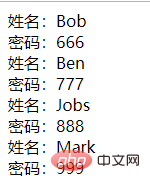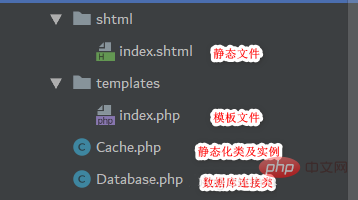 Backend Development
Backend Development
 PHP Tutorial
PHP Tutorial
 Detailed explanation of pure static and pseudo-static usage of PHP page staticization
Detailed explanation of pure static and pseudo-static usage of PHP page staticization
Detailed explanation of pure static and pseudo-static usage of PHP page staticization

The examples in this article describe the pure static and pseudo-static usage of PHP page staticization. Share it with everyone for your reference, the details are as follows:
Why do we need to make the page static?
When a user accesses a not frequently updated Web page, PHP is instructed to parse the php script file and query the data required for the page from the database , then render the page template, and finally display a finished page to the user. A single request is very simple and fast for the server to handle, but what if thousands of different users request the page at the same time? This is undoubtedly a waste of resources, and this is the purpose of doing static.
Staticization is divided into pure static and pseudo-static, and pure static is divided into partial pure static and total pure static.
Related learning recommendations: PHP programming from entry to proficiency
pseudo-static
Pseudo-static, as the name suggests, is not true The static page is disguised. For example, for a web site with PHP as the back-end language, under normal circumstances its URL should be similar to http://www.example.com/index.php. When we do pseudo-static processing , when you visit the same page, the URL displayed may be http://www.example.com/index.html. Its function is to simplify routing and be better indexed by search engines. This method can also be used when you don’t want users to know your back-end language. The routing and redirection knowledge is designed here and will not be explained in detail.
Pure static
- Partial pure static
A page usually consists of multiple parts, such as a blog, which may consist of text, categories, friendship It is composed of links, columns and other parts. Partial staticization can be used when some parts are updated frequently and some parts are updated infrequently.
- All purely static
It is easy to understand after reading the previous content. This method is used when all the content of a page is not updated frequently.
Static page implementation principle
The first thing I want to talk about is a thing called a buffer. Let's give a simple example to illustrate its role: when we edit a document, the system will not write to the disk before we save it, but will write it to the buffer. When the buffer is full or a save operation is performed, , the data will be written to the disk. For PHP, every output operation like echo is also written to the php buffer first. The data will not be displayed on the browser until the script is executed or a forced output caching operation is performed.
Here we are going to do something about this buffer. Before php outputs the content, we take out the content of the buffer (here is the rendered template content), and then write it into a static file and set it Expiration time, when the user visits the page next time, if the static file exists and is within the validity period, we will directly display the static file to the user, otherwise we will rewrite the static file.
The code implements
database connection, using the singleton mode.
Database.php
<?php
class Database {
//用于保存实例化对象
private static $instance;
//用于保存数据库句柄
private $db = null;
//禁止直接实例化,负责数据库连接,将数据库连接句柄保存至私有变量$db
private function __construct($options) {
$this->db = mysqli_connect($options['db_host'], $options['db_user'], $options['db_password'], $options['db_database']);
}
//负责实例化数据库类,返回实例化后的对象
public static function getInstance($options) {
if (!(self::$instance instanceof self)) {
self::$instance = new self($options);
}
return self::$instance;
}
//获取数据库连接句柄
public function db() {
return $this->db;
}
//禁止克隆
private function __clone() {
// TODO: Implement __clone() method.
}
//禁止重构
private function __wakeup() {
// TODO: Implement __wakeup() method.
}
}Used for static pages
Cache.php
<?php
class Cache {
public function index($options) {
//判断文件是否存在,判断是否过期
if (is_file('shtml/index.shtml') && (time() - filemtime('shtml/index.shtml') < 300)) {
require_once ('index.shtml');
}else {
require_once ('Database.php');
$con = Database::getInstance($options)->db();
$sql = "SELECT * FROM pro_test";
$exe_res = mysqli_query($con, $sql);
$res = mysqli_fetch_all($exe_res);
try{
if (!$res) {
throw new Exception("no result");
}
}catch (Exception $e) {
echo 'Message: ' .$e->getMessage();
}
//开启缓存区,这后面的内容都会进缓存区
ob_start();
//引入模板文件(模板会渲染数据)
require_once ('templates/index.php');
//取出缓存区内容(在这里是渲染后的模板),将其保存(默认会覆盖原来的)为index.shtml(static html)
file_put_contents('shtml/index.shtml', ob_get_contents());
}
}
}
//数据库配置信息
$options = [
'db_host' => 'mysql',
'db_user' => 'root',
'db_password' => 'localhost',
'db_database' => 'pro_shop',
];
$obj = new Cache();
$obj->index($options);template/index.php
<!DOCTYPE>
<html>
<head>
<meta charset="UTF-8">
<title>首页</title>
</head>
<body>
<?php foreach ($res as $item) {?>
<p>姓名:<?php echo $item[1]?></p>
<p>密码:<?php echo $item[2]?></p>
<?php }?>
</body>
</html>Browser accesslocalhost/Cache.php



The above is the detailed content of Detailed explanation of pure static and pseudo-static usage of PHP page staticization. For more information, please follow other related articles on the PHP Chinese website!

Hot AI Tools

Undresser.AI Undress
AI-powered app for creating realistic nude photos

AI Clothes Remover
Online AI tool for removing clothes from photos.

Undress AI Tool
Undress images for free

Clothoff.io
AI clothes remover

Video Face Swap
Swap faces in any video effortlessly with our completely free AI face swap tool!

Hot Article

Hot Tools

Notepad++7.3.1
Easy-to-use and free code editor

SublimeText3 Chinese version
Chinese version, very easy to use

Zend Studio 13.0.1
Powerful PHP integrated development environment

Dreamweaver CS6
Visual web development tools

SublimeText3 Mac version
God-level code editing software (SublimeText3)

Hot Topics
 PHP 8.4 Installation and Upgrade guide for Ubuntu and Debian
Dec 24, 2024 pm 04:42 PM
PHP 8.4 Installation and Upgrade guide for Ubuntu and Debian
Dec 24, 2024 pm 04:42 PM
PHP 8.4 brings several new features, security improvements, and performance improvements with healthy amounts of feature deprecations and removals. This guide explains how to install PHP 8.4 or upgrade to PHP 8.4 on Ubuntu, Debian, or their derivati
 7 PHP Functions I Regret I Didn't Know Before
Nov 13, 2024 am 09:42 AM
7 PHP Functions I Regret I Didn't Know Before
Nov 13, 2024 am 09:42 AM
If you are an experienced PHP developer, you might have the feeling that you’ve been there and done that already.You have developed a significant number of applications, debugged millions of lines of code, and tweaked a bunch of scripts to achieve op
 How To Set Up Visual Studio Code (VS Code) for PHP Development
Dec 20, 2024 am 11:31 AM
How To Set Up Visual Studio Code (VS Code) for PHP Development
Dec 20, 2024 am 11:31 AM
Visual Studio Code, also known as VS Code, is a free source code editor — or integrated development environment (IDE) — available for all major operating systems. With a large collection of extensions for many programming languages, VS Code can be c
 Explain JSON Web Tokens (JWT) and their use case in PHP APIs.
Apr 05, 2025 am 12:04 AM
Explain JSON Web Tokens (JWT) and their use case in PHP APIs.
Apr 05, 2025 am 12:04 AM
JWT is an open standard based on JSON, used to securely transmit information between parties, mainly for identity authentication and information exchange. 1. JWT consists of three parts: Header, Payload and Signature. 2. The working principle of JWT includes three steps: generating JWT, verifying JWT and parsing Payload. 3. When using JWT for authentication in PHP, JWT can be generated and verified, and user role and permission information can be included in advanced usage. 4. Common errors include signature verification failure, token expiration, and payload oversized. Debugging skills include using debugging tools and logging. 5. Performance optimization and best practices include using appropriate signature algorithms, setting validity periods reasonably,
 PHP Program to Count Vowels in a String
Feb 07, 2025 pm 12:12 PM
PHP Program to Count Vowels in a String
Feb 07, 2025 pm 12:12 PM
A string is a sequence of characters, including letters, numbers, and symbols. This tutorial will learn how to calculate the number of vowels in a given string in PHP using different methods. The vowels in English are a, e, i, o, u, and they can be uppercase or lowercase. What is a vowel? Vowels are alphabetic characters that represent a specific pronunciation. There are five vowels in English, including uppercase and lowercase: a, e, i, o, u Example 1 Input: String = "Tutorialspoint" Output: 6 explain The vowels in the string "Tutorialspoint" are u, o, i, a, o, i. There are 6 yuan in total
 How do you parse and process HTML/XML in PHP?
Feb 07, 2025 am 11:57 AM
How do you parse and process HTML/XML in PHP?
Feb 07, 2025 am 11:57 AM
This tutorial demonstrates how to efficiently process XML documents using PHP. XML (eXtensible Markup Language) is a versatile text-based markup language designed for both human readability and machine parsing. It's commonly used for data storage an
 Explain late static binding in PHP (static::).
Apr 03, 2025 am 12:04 AM
Explain late static binding in PHP (static::).
Apr 03, 2025 am 12:04 AM
Static binding (static::) implements late static binding (LSB) in PHP, allowing calling classes to be referenced in static contexts rather than defining classes. 1) The parsing process is performed at runtime, 2) Look up the call class in the inheritance relationship, 3) It may bring performance overhead.
 What are PHP magic methods (__construct, __destruct, __call, __get, __set, etc.) and provide use cases?
Apr 03, 2025 am 12:03 AM
What are PHP magic methods (__construct, __destruct, __call, __get, __set, etc.) and provide use cases?
Apr 03, 2025 am 12:03 AM
What are the magic methods of PHP? PHP's magic methods include: 1.\_\_construct, used to initialize objects; 2.\_\_destruct, used to clean up resources; 3.\_\_call, handle non-existent method calls; 4.\_\_get, implement dynamic attribute access; 5.\_\_set, implement dynamic attribute settings. These methods are automatically called in certain situations, improving code flexibility and efficiency.





